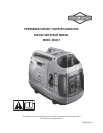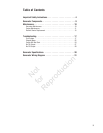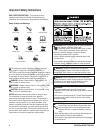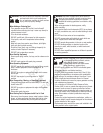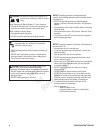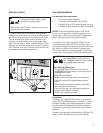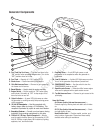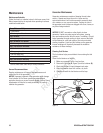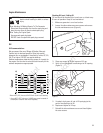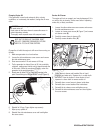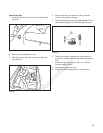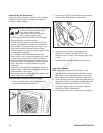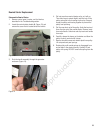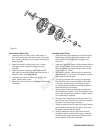
7
WARNING
Exhaust heat/gases could ignite combustibles
or structures resulting in death, serious
injury and/or property damage.
• Keep at least 5 feet (152 cm) of clearance on all sides of
generator including overhead.
Generator Location
For proper clearance and air movement, place generator
outdoors in an area that will not accumulate deadly exhaust
gas. DO NOT place generator where exhaust gas (A, Figure
1) could accumulate and enter inside or be drawn into a
potentially occupied building. Ensure exhaust gas is kept
away from any windows, doors, ventilation intakes, or other
openings that can allow exhaust gas to collect in a confined
area. Prevailing winds and air currents should be taken into
consideration when positioning generator.
Fuel Recommendations
Fuel must meet these requirements:
• Clean. fresh, unleaded gasoline
• A minimum of 87 octane/87 AKI (91 RON)
• Gasoline with up to 10% ethanol (gasohol) or up to
15%MTBE (methyl tertiary butyl ether) is acceptable.
NOTICE: Do not use unapproved gasoline, such as E85.
Do not mix oil in gasoline or modify the engine to run on
alternate fuels. Failure to follow will result in damage to the
engine and/or generator and will void the warranty.
To protect the fuel system from gum formation, mix in a
fuel stabilizer when adding fuel. All fuel is not the same. If
you experience starting or performance problems after using
fuel, switch to a different fuel provider or change brands.
This engine is certified to operate on gasoline. The emission
control system for this engine is EM (Engine Modifications).
WARNING Fuel and its vapors are extremely flammable
and explosive which could cause burns,
fire, or explosion resulting in death, serious
injury, and/or property damage.
When Adding or Draining Fuel
• Turn generator engine OFF and let it cool at least 2
minutes before removing fuel cap. Loosen cap slowly to
relieve pressure in tank.
• Fill or drain tank outdoors.
• DO NOT overfill tank. Allow space for fuel expansion.
• If fuel spills, wait until it evaporates before starting
engine.
• Keep fuel away from sparks, open flames, pilot lights,
heat, and other ignition sources.
• Check fuel lines, tank, cap, and fittings frequently for
cracks or leaks. Replace if necessary.
• DO NOT light a cigarette or smoke.
High Altitude
At altitudes over 5,000 feet (1524 meters), a minimum 85
octane / 85 AKI (89 RON) gasoline is acceptable. To remain
emissions compliant, high altitude adjustment is required.
Operation without this adjustment will cause decreased
performance, increased fuel consumption, and increased
emissions.
Operation of the generator at altitudes below 2,500 feet (762
meters) with the high altitude kit is not recommended.
Figure 1
A
Not
for
Reproduction



